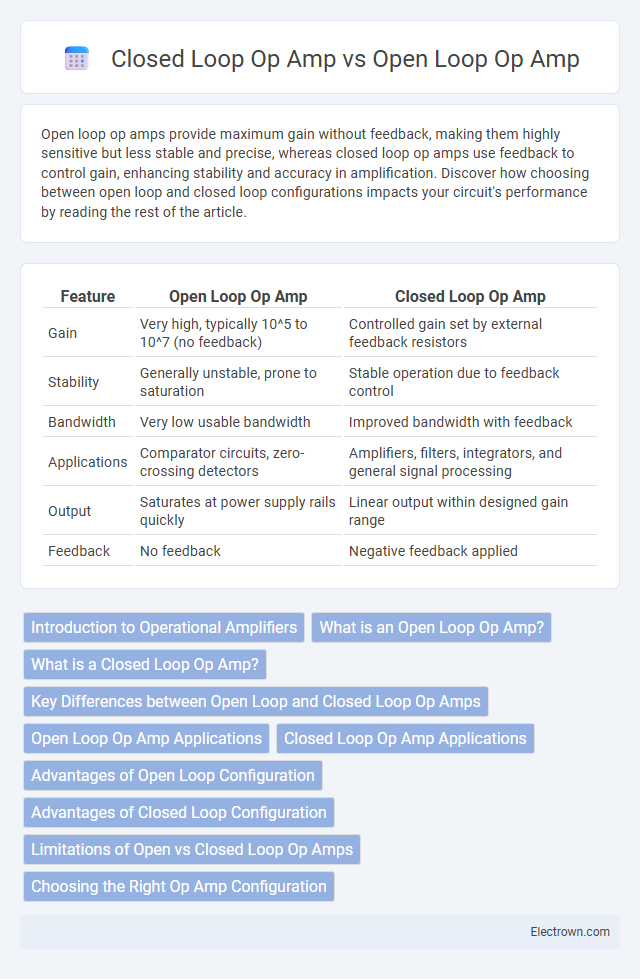Open loop op amps provide maximum gain without feedback, making them highly sensitive but less stable and precise, whereas closed loop op amps use feedback to control gain, enhancing stability and accuracy in amplification. Discover how choosing between open loop and closed loop configurations impacts your circuit's performance by reading the rest of the article.
Table of Comparison
| Feature | Open Loop Op Amp | Closed Loop Op Amp |
|---|---|---|
| Gain | Very high, typically 10^5 to 10^7 (no feedback) | Controlled gain set by external feedback resistors |
| Stability | Generally unstable, prone to saturation | Stable operation due to feedback control |
| Bandwidth | Very low usable bandwidth | Improved bandwidth with feedback |
| Applications | Comparator circuits, zero-crossing detectors | Amplifiers, filters, integrators, and general signal processing |
| Output | Saturates at power supply rails quickly | Linear output within designed gain range |
| Feedback | No feedback | Negative feedback applied |
Introduction to Operational Amplifiers
Operational amplifiers (op amps) function in two primary configurations: open loop and closed loop. Open loop op amps have extremely high gain but lack stability and are rarely used alone due to their susceptibility to saturation from minor input differences. Closed loop op amps incorporate feedback, drastically reducing gain to a controlled level while enhancing stability, linearity, and bandwidth, making them ideal for practical amplification applications.
What is an Open Loop Op Amp?
An open loop op amp is an operational amplifier configured without any feedback, resulting in a very high gain, often exceeding 100,000. This configuration is primarily used for understanding the amplifier's maximum output swing and input offset voltage rather than practical amplification, as it can saturate easily with even tiny input signals. You should consider open loop op amps when designing comparators or for educational purposes to analyze the intrinsic properties of the device.
What is a Closed Loop Op Amp?
A closed loop op amp uses feedback to control its gain and improve stability, accuracy, and bandwidth. By connecting the output back to the input through resistors or other components, the closed loop reduces distortion and limits the amplification to a precise, predetermined level. Your circuit benefits from enhanced performance and predictable behavior compared to an open loop op amp, which operates with extremely high gain and no feedback control.
Key Differences between Open Loop and Closed Loop Op Amps
Open loop op amps operate with maximum gain and no feedback, resulting in high sensitivity and limited stability, primarily used in comparator applications. Closed loop op amps employ feedback to control gain, enhancing linearity, stability, and bandwidth for precise amplification in analog circuits. The key difference lies in feedback utilization, where closed loop configurations provide predictable gain and improved performance, unlike the open loop's uncontrolled high gain.
Open Loop Op Amp Applications
Open loop op amp applications primarily include comparator circuits and zero-crossing detectors where high gain without feedback is essential. These amplifiers operate with maximum gain, making them suitable for rapid switching and threshold detection tasks. Your design benefits from understanding that open loop configurations excel in applications requiring precise trigger points rather than linear amplification.
Closed Loop Op Amp Applications
Closed loop op amps are extensively used in signal amplification, filtering, and feedback control systems due to their improved stability and linearity. They provide precise gain control in audio amplifiers, instrumentation amplifiers, and active filters by utilizing negative feedback to minimize distortion and noise. Closed loop configurations enable accurate voltage regulation and waveform generation in electronic devices and control systems.
Advantages of Open Loop Configuration
Open loop op amps provide extremely high gain, making them ideal for applications requiring signal comparison and detecting minute voltage differences. Their simple design eliminates feedback components, reducing complexity and improving response speed in fast-switching circuits. This configuration is advantageous in applications such as comparators and zero-crossing detectors where precise gain control is less critical.
Advantages of Closed Loop Configuration
Closed loop op amps provide improved stability and precision by utilizing negative feedback to control gain, making them highly reliable for accurate signal amplification. Your circuits benefit from reduced distortion and enhanced bandwidth, as the closed loop configuration minimizes the impact of input offset voltage and temperature variations. This results in consistent performance across varying operating conditions, ideal for most real-world applications compared to open loop op amps.
Limitations of Open vs Closed Loop Op Amps
Open loop op amps suffer from extremely high gain that leads to instability and makes precise amplification impossible without external feedback, resulting in nonlinear output and saturation issues. Closed loop op amps incorporate feedback networks that significantly improve linearity, bandwidth, and gain accuracy while reducing distortion and noise. The feedback in closed loop configurations also enhances input and output impedance characteristics, overcoming the major limitations inherent in open loop operation.
Choosing the Right Op Amp Configuration
Choosing the right op amp configuration depends on the desired gain stability and bandwidth requirements. Open loop op amps offer extremely high gain but lack feedback control, making them suitable for comparator applications rather than precise amplification. Closed loop op amps utilize feedback to regulate gain, improve linearity, and reduce distortion, ideal for accurate signal processing and amplification tasks.
open loop op amp vs closed loop op amp Infographic

 electrown.com
electrown.com